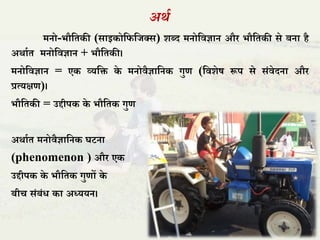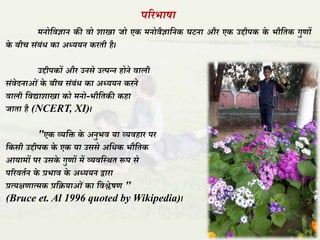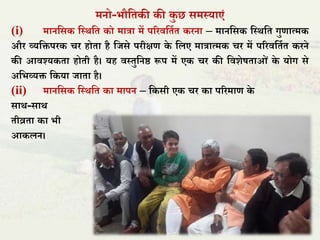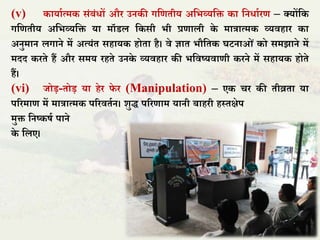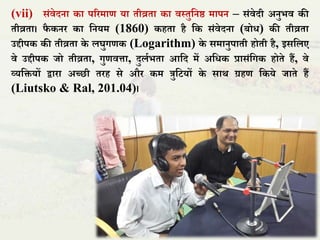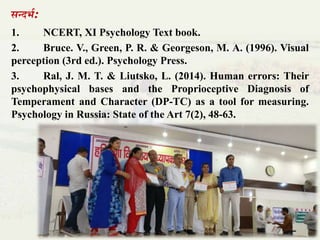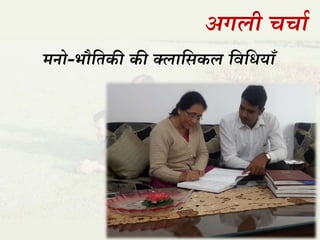рдордиреЛ-рднреМрддрд┐рдХреА рдХреА рд╕рдорд╕реНрдпрд╛рдПрдВ (Problems of Psychophysics)
- 1. рдордиреЛ-рднреМрддрд┐рдХреА рдХреА рд╕рдорд╕реНрдпрд╛рдПрдВ рдбреЙ рд░рд╛рдЬреЗрд╢ рд╡рдорд╛рд╛ рдЕрддрд╕рд╕реНрдЯреЗрдВрдЯ рдкреНрд░реЛрдлреЗ рд╕рд░ (рдордиреЛрддрд╡рдЬреНрдЮрд╛рди) рд░рд╛рдЬрдХреАрдп рдорд╣рд╛рддрд╡рджреНрдпрд╛рд▓рдп рдЖрджрдордкреБрд░, рддрд╣рд╕рд╛рд░, рд╣рд░рд░рдпрд╛рдгрд╛
- 2. рдЕрд░реНрд╛ рдордиреЛ-рднреМрддрд┐рдХреА (рд╕рд╛рдЗрдХреЛрддрд┐рддрд┐рдХреНрд╕) рд╢рдмреНрдж рдордиреЛрддрд┐рдЬреНрдЮрд╛рди рдФрд░ рднреМрддрд┐рдХреА рд╕реЗ рдмрдирд╛ рд╣реИ рдЕрд░реНрд╛рд╛рд┐ рдордиреЛрддрд┐рдЬреНрдЮрд╛рди + рднреМрддрд┐рдХреАред рдордиреЛрддрд┐рдЬреНрдЮрд╛рди = рдПрдХ рд╡реНрдпрддрд┐ рдХреЗ рдордиреЛрд┐реИрдЬреНрдЮрд╛рддрдирдХ рдЧреБрдг (рддрд┐рд╢реЗрд╖ рд░реВрдк рд╕реЗ рд╕рдВрд┐реЗрджрдирд╛ рдФрд░ рдкреНрд░рддреНрдпрдХреНрд╖рдг)ред рднреМрддрд┐рдХреА = рдЙрджреНрджреАрдкрдХ рдХреЗ рднреМрддрд┐рдХ рдЧреБрдг рдЕрд░реНрд╛рд╛рд┐ рдордиреЛрд┐реИрдЬреНрдЮрд╛рддрдирдХ рдШрдЯрдирд╛ (phenomenon ) рдФрд░ рдПрдХ рдЙрджреНрджреАрдкрдХ рдХреЗ рднреМрддрд┐рдХ рдЧреБрдгреЛрдВ рдХреЗ рдмреАрдЪ рд╕рдВрдмрдВрдз рдХрд╛ рдЕрдзреНрдпрдпрдиред
- 3. рдкрд░рд░рднрд╛рд╖рд╛ рдордиреЛрддрд╡рдЬреНрдЮрд╛рди рдХреА рд╡реЛ рд╢рд╛рдЦрд╛ рдЬреЛ рдПрдХ рдордиреЛрд╡реИрдЬреНрдЮрд╛рддрдирдХ рдШрдЯрдирд╛ рдФрд░ рдПрдХ рдЙрджреНрджреАрдкрдХ рдХреЗ рднреМрддрд┐рдХ рдЧреБрдгреЛрдВ рдХреЗ рдмреАрдЪ рд╕рдВрдмрдВрдз рдХрд╛ рдЕрдзреНрдпрдпрди рдХрд░рд┐реА рд╣реИред рдЙрджреНрджреАрдкрдХреЛрдВ рдФрд░ рдЙрдирд╕реЗ рдЙрддреНрдкрдиреНрди рд╣реЛрдиреЗ рд╡рд╛рд▓реА рд╕рдВрд╡реЗрджрдирд╛рдУрдВ рдХреЗ рдмреАрдЪ рд╕рдВрдмрдВрдз рдХрд╛ рдЕрдзреНрдпрдпрди рдХрд░рдиреЗ рд╡рд╛рд▓реА рддрд╡рджреНрдпрд╛рд╢рд╛рдЦрд╛ рдХреЛ рдордиреЛ-рднреМрддрд┐рдХреА рдХрд╣рд╛ рдЬрд╛рд┐рд╛ рд╣реИ (NCERT, XI)ред "рдПрдХ рд╡реНрдпрддрд┐ рдХреЗ рдЕрдиреБрднрд╡ рдпрд╛ рд╡реНрдпрд╡рд╣рд╛рд░ рдкрд░ рддрдХрд╕реА рдЙрджреНрджреАрдкрдХ рдХреЗ рдПрдХ рдпрд╛ рдЙрд╕рд╕реЗ рдЕрддрдзрдХ рднреМрддрд┐рдХ рдЖрдпрд╛рдореЛрдВ рдкрд░ рдЙрд╕рдХреЗ рдЧреБрдгреЛрдВ рдореЗрдВ рд╡реНрдпрд╡рддрд╕реНрд░реНрд┐ рд░реВрдк рд╕реЗ рдкрд░рд░рд╡рд┐рд╛рди рдХреЗ рдкреНрд░рднрд╛рд╡ рдХреЗ рдЕрдзреНрдпрдпрди рджреНрд╡рд╛рд░рд╛ рдкреНрд░рддреНрдпрдХреНрд╖рдгрд╛рддреНрдордХ рдкреНрд░рддрд┐рдпрд╛рдУрдВ рдХрд╛ рддрд╡рд╢реНрд▓реЗрд╖рдг " (Bruce et. Al 1996 quoted by Wikipedia)ред
- 4. рдордиреЛ-рднреМрддрд┐рдХреА рдХреА рдХреБ рдЫ рд╕рдорд╕реНрдпрд╛рдПрдВ (i) рдорд╛рдирддрд╕рдХ рддрд╕реНрд░реНрддрд┐ рдХреЛ рдорд╛рддреНрд░рд╛ рдореЗрдВ рдкрд░рд░рд┐рддрд┐рд╛рд┐ рдХрд░рдирд╛ тАУ рдорд╛рдирддрд╕рдХ рддрд╕реНрд░реНрддрд┐ рдЧреБрдгрд╛рддреНрдордХ рдФрд░ рд╡реНрдпрддрд┐рдкрд░рдХ рдЪрд░ рд╣реЛрд┐рд╛ рд╣реИ рддрд┐рд╕реЗ рдкрд░реАрдХреНрд╖рдг рдХреЗ рддрд┐рдП рдорд╛рддреНрд░рд╛рддреНрдордХ рдЪрд░ рдореЗрдВ рдкрд░рд░рд┐рддрд┐рд╛рд┐ рдХрд░рдиреЗ рдХреА рдЖрд┐рд╢реНрдпрдХрд┐рд╛ рд╣реЛрд┐реА рд╣реИред рдпрд╣ рд┐рд╕реНрд┐реБрддрдирд╖реНрда рд░реВрдк рдореЗрдВ рдПрдХ рдЪрд░ рдХреА рддрд┐рд╢реЗрд╖рд┐рд╛рдУрдВ рдХреЗ рдпреЛрдЧ рд╕реЗ рдЕрддрднрд╡реНрдпрд┐ рддрдХрдпрд╛ рд┐рд╛рд┐рд╛ рд╣реИред (ii) рдорд╛рдирддрд╕рдХ рддрд╕реНрд░реНрддрд┐ рдХрд╛ рдорд╛рдкрди тАУ рддрдХрд╕реА рдПрдХ рдЪрд░ рдХрд╛ рдкрд░рд░рдорд╛рдг рдХреЗ рд╕рд╛рд░реН-рд╕рд╛рд░реН рд┐реАрд╡реНрд░рд┐рд╛ рдХрд╛ рднреА рдЖрдХрд┐рдиред
- 5. (iii) рдорд╛рдкрдХреНрд░рдо рдпрд╛ рдкреИрдорд╛рдирд╛ рд┐реИрдпрд╛рд░ рдХрд░рдирд╛ (рд╕реНрдХреЗ рддрд┐рдВрдЧ) тАУ рдПрдХ рдкреИрдорд╛рдиреЗ рдпрд╛ рдЕрдмрд╛рдз рдХреНрд░рдо (Continuum) рдкрд░ рддрдХрд╕реА рд┐рд╕реНрд┐реБ рдпрд╛ рдордиреЛрд┐реИрдЬреНрдЮрд╛рддрдирдХ рдЪрд░ рдХрд╛ рд╕реНрд░реНрд╛рди рддрдирдзрд╛рд╛рд░рд░рд┐ рдХрд░рдирд╛ рдЕрд░реНрд╛рд╛рд┐ рдПрдХ рд╕рдВрдЦреНрдпрд╛рддреНрдордХ рдореВрд▓реНрдп рдЖрд┐рдВрддрдЯрд┐ рдХрд░рдирд╛ред рдпрд╣ рдЪрд░реЛрдВ рдХреЗ рдмреАрдЪ рдХрд╛рд░рдг-рдкреНрд░рднрд╛рд┐ рд╕рдВрдмрдВрдз рд╕реНрд░реНрд╛рддрдкрд┐ рдХрд░рдиреЗ рдореЗрдВ рд╕рд╣рд╛рдпрдХ рд╣реЛрд┐реЗ рд╣реИрдВред (iv) рд╕рдВрд┐реЗрддрджрдХ рдЕрдиреБрднрд┐ рдХрд╛ рдорд╛рдкрди рдПрд┐рдВ рдЙрдирдХреЗ рд╕реНрд┐рд░ рдХрд╛ рдЖрдХрд┐рди рдЕрд░реНрд╛рд╛рд┐ рдЙрди рдЕрдиреБрднрд┐реЛрдВ рдХреЛ рдПрдХ рд╕рдВрдЦреНрдпрд╛рддреНрдордХ рдореВрд▓реНрдп (рдиреНрдпреВрдореЗрд░рд░рдХрд┐ рд┐реИрд▓реНрдпреВ) рджреЗрдирд╛ред
- 6. (v) рдХрд╛рдпрд╛рд╛рддреНрдордХ рд╕рдВрдмрдВрдзреЛрдВ рдФрд░ рдЙрдирдХреА рдЧрддрдгрд┐реАрдп рдЕрддрднрд╡реНрдпрддрд┐ рдХрд╛ рддрдирдзрд╛рд╛рд░рдг тАУ рдХреНрдпреЛрдВрддрдХ рдЧрддрдгрд┐реАрдп рдЕрддрднрд╡реНрдпрддрд┐ рдпрд╛ рдореЙрдбрд┐ рддрдХрд╕реА рднреА рдкреНрд░рдгрд╛рд┐реА рдХреЗ рдорд╛рддреНрд░рд╛рддреНрдордХ рд╡реНрдпрд┐рд╣рд╛рд░ рдХрд╛ рдЕрдиреБрдорд╛рди рд┐рдЧрд╛рдиреЗ рдореЗрдВ рдЕрддреНрдпрдВрд┐ рд╕рд╣рд╛рдпрдХ рд╣реЛрд┐рд╛ рд╣реИред рд┐реЗ рдЬреНрдЮрд╛рд┐ рднреМрддрд┐рдХ рдШрдЯрдирд╛рдУрдВ рдХреЛ рд╕рдордЭрд╛рдиреЗ рдореЗрдВ рдорджрдж рдХрд░рд┐реЗ рд╣реИрдВ рдФрд░ рд╕рдордп рд░рд╣рд┐реЗ рдЙрдирдХреЗ рд╡реНрдпрд┐рд╣рд╛рд░ рдХреА рднрддрд┐рд╖реНрдпрд┐рд╛рдгреА рдХрд░рдиреЗ рдореЗрдВ рд╕рд╣рд╛рдпрдХ рд╣реЛрд┐реЗ рд╣реИрдВред (vi) рд┐реЛрдбрд╝-рд┐реЛрдбрд╝ рдпрд╛ рд╣реЗрд░ рд┐реЗ рд░ (Manipulation) тАУ рдПрдХ рдЪрд░ рдХреА рд┐реАрд╡реНрд░рд┐рд╛ рдпрд╛ рдкрд░рд░рдорд╛рдг рдореЗрдВ рдорд╛рддреНрд░рд╛рддреНрдордХ рдкрд░рд░рд┐рд┐рд╛рдиред рд╢реБрджреНрдз рдкрд░рд░рдгрд╛рдо рдпрд╛рдиреА рдмрд╛рд╣рд░реА рд╣рд╕реНрд┐рдХреНрд╖реЗрдк рдореБрд┐ рддрдирд╖реНрдХрд╖рд╛ рдкрд╛рдиреЗ рдХреЗ рддрд┐рдПред
- 7. (vii) рд╕рдВрд┐реЗрджрдирд╛ рдХрд╛ рдкрд░рд░рдорд╛рдг рдпрд╛ рд┐реАрд╡реНрд░рд┐рд╛ рдХрд╛ рд┐рд╕реНрд┐реБрддрдирд╖реНрда рдорд╛рдкрди тАУ рд╕рдВрд┐реЗрджреА рдЕрдиреБрднрд┐ рдХреА рд┐реАрд╡реНрд░рд┐рд╛ред рд┐реИ рдХрдирд░ рдХрд╛ рддрдирдпрдо (1860) рдХрд╣рд┐рд╛ рд╣реИ рддрдХ рд╕рдВрд┐реЗрджрдирд╛ (рдмреЛрдз) рдХреА рд┐реАрд╡реНрд░рд┐рд╛ рдЙрджреНрджреАрдкрдХ рдХреА рд┐реАрд╡реНрд░рд┐рд╛ рдХреЗ рд┐рдШреБрдЧрдгрдХ (Logarithm) рдХреЗ рд╕рдорд╛рдиреБрдкрд╛рд┐реА рд╣реЛрд┐реА рд╣реИ, рдЗрд╕рддрд┐рдП рд┐реЗ рдЙрджреНрджреАрдкрдХ рд┐реЛ рд┐реАрд╡реНрд░рд┐рд╛, рдЧреБрдгрд┐рддреНрддрд╛, рджреБрд┐рд╛рднрд┐рд╛ рдЖрддрдж рдореЗрдВ рдЕрддрдзрдХ рдкреНрд░рд╛рд╕рдВрддрдЧрдХ рд╣реЛрд┐реЗ рд╣реИрдВ, рд┐реЗ рд╡реНрдпрддрд┐рдпреЛрдВ рджреНрд╡рд╛рд░рд╛ рдЕрдЪреНрдЫреА рд┐рд░рд╣ рд╕реЗ рдФрд░ рдХрдо рддреНрд░реБрддрдЯрдпреЛрдВ рдХреЗ рд╕рд╛рд░реН рдЧреНрд░рд╣рдг рддрдХрдпреЗ рд┐рд╛рд┐реЗ рд╣реИрдВ (Liutsko & Ral, 201.04)ред
- 8. (viii) рдорд╛рдирд┐реАрдп рддреНрд░реБрддрдЯрдпреЛрдВ рдХреЛ рдХрдо рд╕реЗ рдХрдо рдХрд░рдирд╛ рд┐реЛ рдореБрдЦреНрдпрд┐рдГ рд┐реАрди рдкреНрд░рдХрд╛рд░ рдХреА рд╣реЛрд┐реА рд╣реИрдВ: - (a) рдкреНрд░рддреНрдпрдХреНрд╖рдг рдореЗрдВ, (b) рддрдирдгрд╛рдп рд▓реЗрдиреЗ рдореЗрдВ рдФрд░ (c) рд╕рдВрд╡реЗрджрдирд╛ рдореЗрдВред (ix) рдЕрд┐рд┐реЛрдХрди рд╕рдВрдмрдВрдзреА рддреНрд░реБрддрдЯрдпрд╛рдВред
- 9. рд╕рдиреНрджрднрд╛: 1. NCERT, XI Psychology Text book. 2. Bruce. V., Green, P. R. & Georgeson, M. A. (1996). Visual perception (3rd ed.). Psychology Press. 3. Ral, J. M. T. & Liutsko, L. (2014). Human errors: Their psychophysical bases and the Proprioceptive Diagnosis of Temperament and Character (DP-TC) as a tool for measuring. Psychology in Russia: State of the Art 7(2), 48-63.
- 10. рдЕрдЧрд▓реА рдЪрдЪрд╛рд╛ рдордиреЛ-рднреМрддрд┐рдХреА рдХреА рдХреНрд▓рд╛рддрд╕рдХрд▓ рддрд╡рддрдзрдпрд╛
- 11. рдзрдиреНрдпрд╡рд╛рдж рддрдлрд░ рддрдорд▓реЗрдВрдЧреЗ рдЕрдЧрд▓реА рд╡реАрддрдбрдпреЛ рдХреЗ рд╕рд╛рд░реН vermasujit@yahoo.com


